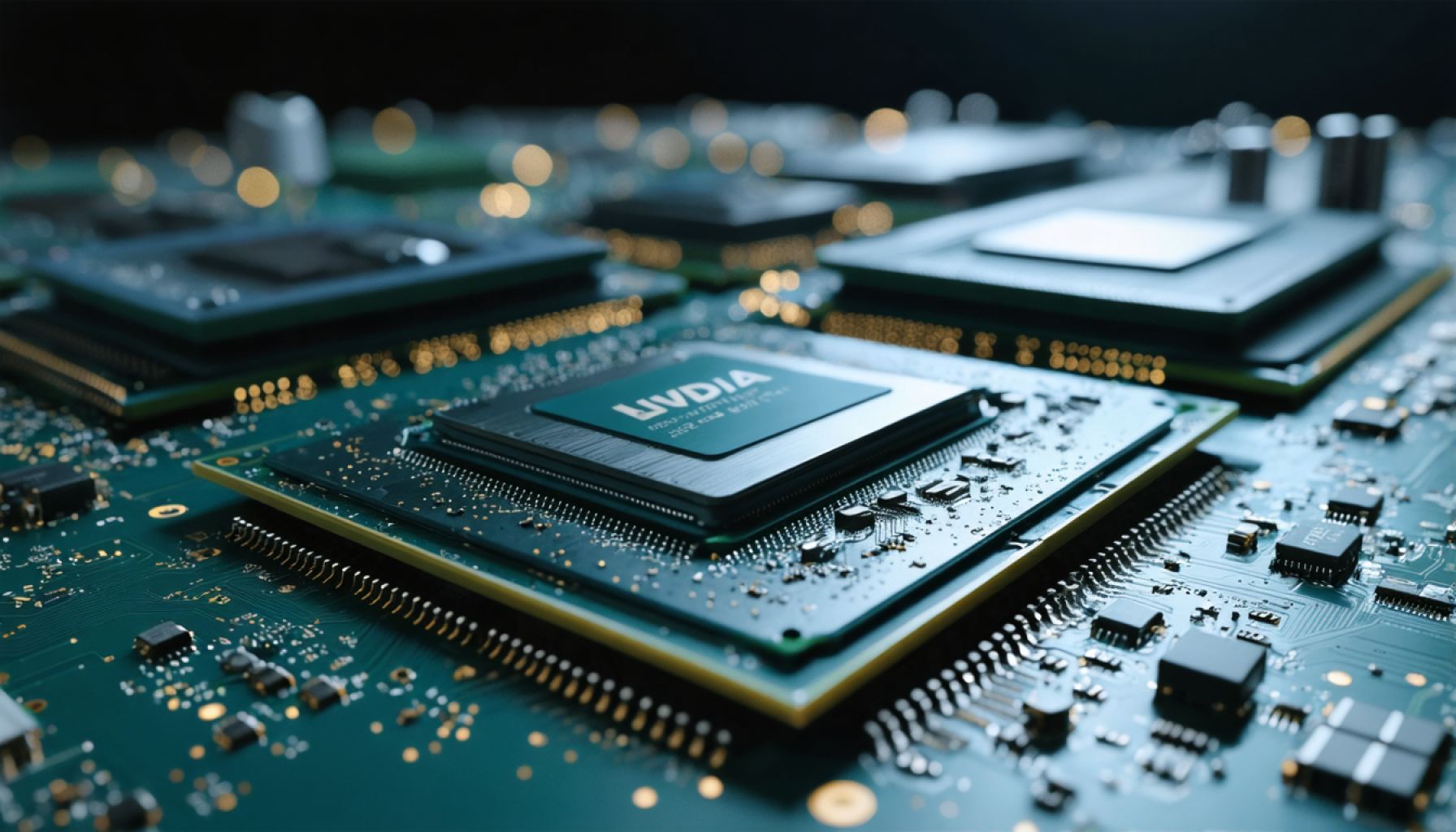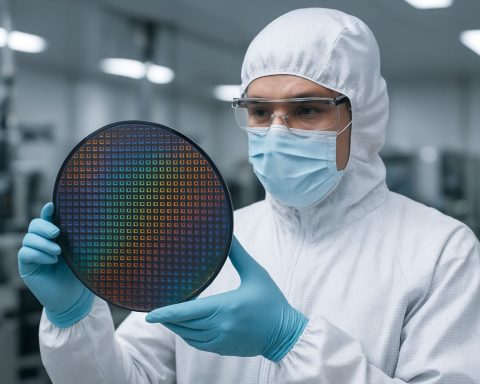- The semiconductor industry is pivotal to modern technology, with Intel and Nvidia as key players.
- Intel is attempting a comeback with strategic pivots, despite setbacks like a revenue dip to $53.1 billion in 2024 and recent net losses.
- Nvidia experiences impressive growth, with fiscal 2025 revenue up 114% to $130.5 billion, driven by innovation and AI advancements.
- The Blackwell Ultra platform underscores Nvidia’s leadership in AI, enhancing technologies that simulate human reasoning.
- Nvidia’s advantage lies in its strategic focus, strong revenue growth, and the absence of heavy fabrication costs.
- Despite Intel’s potentially undervalued stock, Nvidia’s success story in the AI-driven world sets a benchmark for sustainability and growth.
In a world where microchips govern everything from your smartphone to the most advanced artificial intelligence systems, the stakes in the semiconductor industry have never been higher. Nestled in the heart of this technological revolution are two juggernauts: Intel and Nvidia, each carving its path in the rapidly evolving landscape of AI-driven demand.
Once the undisputed leader in personal computing, Intel now finds itself at a crossroads. Its stock, undervalued by market metrics, tells a tale of missed opportunities and strategic recalibrations. Despite a dip in its 2024 revenue to $53.1 billion and net losses punctuated by escalating costs, Intel offers a glimmer of hope. The company’s pivot towards manufacturing chips for powerhouses like Microsoft and Amazon demonstrates its commitment to reclaiming lost ground. Upcoming launches, like the Panther Lake PC chip, hint at potential revitalization. However, the lingering question remains: can Intel innovate quickly enough and at scale to keep pace with its competitors?
Meanwhile, Nvidia is forging ahead, untethered by the costly physical infrastructures of semiconductor fabrication. The company has leaned into the strength of design and innovation, capturing a booming market that sees AI technologies transition from nascent concepts to integral components of daily life. The numbers speak volumes, with Nvidia’s fiscal 2025 revenue soaring 114% year over year to a staggering $130.5 billion. Its cutting-edge Blackwell Ultra platform represents a frontier in AI, elevating the technology to simulate human-like reasoning. Such advancements not only cater to but actively shape the future demands of tech behemoths like Microsoft and Amazon.
The narrative of Intel versus Nvidia isn’t merely one of financial metrics. It is a tale of strategic focus. Nvidia, buoyed by robust revenue growth and a gross margin leaping to 75%, epitomizes what it means to thrive in the age of AI. This adaptability and forward-thinking approach have solidified its status as a leader in the semiconductor world.
The takeaway from this dynamic battle is clear: while Intel might have an enticingly low stock price, Nvidia’s trajectory is underpinned by a potent mix of innovation, strategic partnerships, and market foresight. For investors seeking robust growth and sustainability in the semiconductor sector, Nvidia stands as the archetype of success in the AI era.
Intel vs. Nvidia: The Battle for Semiconductor Supremacy Intensifies
The Current Landscape: Intel vs. Nvidia
The semiconductor industry is a linchpin of modern technology, influencing everything from smartphones to complex AI systems. Within this critical sector, Intel and Nvidia are leading figures, each taking distinctly different paths toward growth and innovation. Understanding their strategies and future directions can provide essential insights for investors, tech enthusiasts, and industry stakeholders.
Intel’s Strategic Pivot and Challenges
1. Focus on Manufacturing: Intel’s decision to manufacture chips for major tech players like Microsoft and Amazon signifies a shift from its traditional role. By leveraging its manufacturing capabilities, Intel aims to recapture market share and influence.
2. Innovation with Panther Lake: The upcoming Panther Lake PC chip is poised to showcase Intel’s renewed focus on innovation. Success with this launch could signal the company’s potential to regain its footing.
3. Revenue and Market Position: Despite a revenue forecast drop to $53.1 billion for 2024 and increased costs leading to net losses, Intel’s undervalued stock may offer strategic buying opportunities for long-term investors.
4. Strategic Partnerships: Collaborations with as-a-service giants like Microsoft’s Azure and AWS can help Intel capitalize on the growth of cloud computing, further integrating its products into increasingly essential business models.
Nvidia’s Ascendant Path
1. Revenue and Innovation: Nvidia’s remarkable fiscal growth of 114%, reaching $130.5 billion in 2025, is a testament to its effective strategy focusing on cutting-edge design and AI technology development.
2. Blackwell Ultra Platform: This platform highlights Nvidia’s commitment to pushing AI advancements, playing a pivotal role in enhancing AI’s practical applications across industries.
3. Market Leadership: With a gross margin of 75%, Nvidia demonstrates how innovation and strategic partnerships contribute to robust financial health and market leadership.
4. Avoidance of Fabrication Costs: Nvidia’s business model, which focuses on design and outsourcing manufacturing, allows the company to invest more in research and development, further promoting innovation.
Pressing Questions and Insights
– Can Intel Innovate Rapidly Enough?: Intel’s success hinges on its ability to innovate swiftly, akin to Nvidia’s agility. This involves embracing and pushing new technologies to market faster.
– What Is the Future of AI in Semiconductors?: The trajectory of AI continues to shape the semiconductor industry, with companies focusing on AI applications that span industries from gaming to automated driving.
– Are Nvidia’s Growth Rates Sustainable?: While Nvidia’s growth is impressive, maintaining such momentum will require constant innovation and strategic expansion into new markets and applications.
Predictions and Market Trends
– AI’s Expanding Role: AI is expected to drive the future of semiconductors, with substantial investments and innovations targeting AI enhancement technologies.
– Increased Demand for Custom Solutions: As tech giants like Microsoft and Amazon continue to expand, the demand for customized semiconductor solutions tailored to specific AI applications is anticipated to rise.
– Potential for Market Disruption: New players and technologies could potentially disrupt existing market dynamics, urging current leaders like Intel and Nvidia to adapt continuously.
Actionable Recommendations for Investors
– Diversify Investments: Consider a diversified portfolio that includes both Intel and Nvidia to balance potential risks and rewards.
– Monitor Technological Developments: Stay updated on both companies’ technological announcements and market movements to make informed investment decisions.
– Watch for Partnerships: Strategic partnerships often signal future trends; monitoring these can offer insights into each company’s strategic direction and potential market growth areas.
By understanding the nuances of Intel’s and Nvidia’s strategies, investors can make informed decisions in navigating the dynamic semiconductor landscape. Whether it’s tapping into Intel’s potential resurgence or riding Nvidia’s growth wave, the opportunities are abundant for those keeping a keen eye on the industry.
For more information on related developments, visit Intel and Nvidia.












